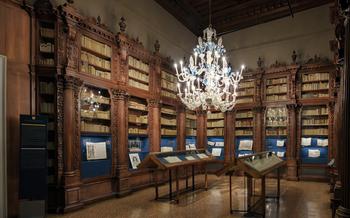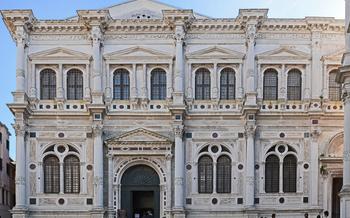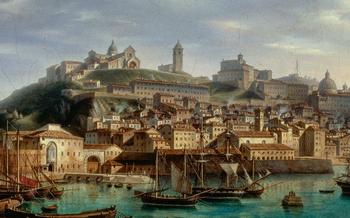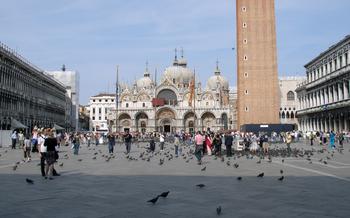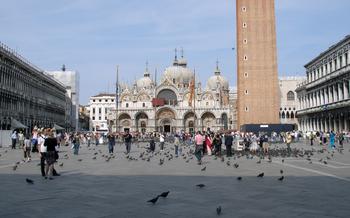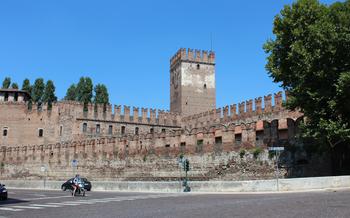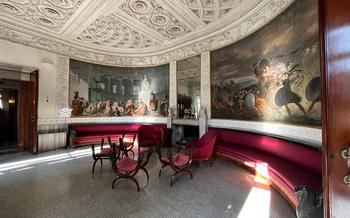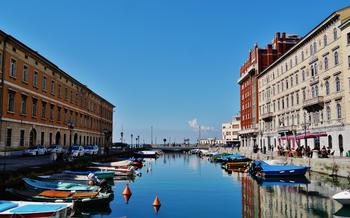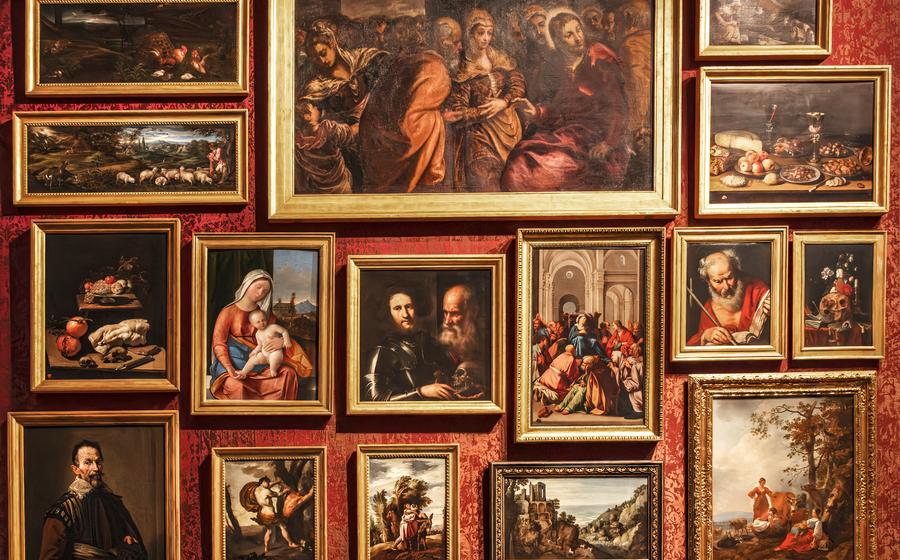
Gallerie dell'Accademia
- The Building
- The Collections
- Titian's Masterpieces
- The Bellini Family
- The Venetian Renaissance
- Veronese and Tintoretto: Masters of Color and Drama
- The 18th-Century Venice
- The Academy of Fine Arts
- Practical Information
- Must-See Paintings
- Off-the-Beaten-Path Gems
- Museum Shop and Cafeteria
- Seek the Secret Study of the Accademia
The Building
The Gallerie dell'Accademia is housed in a former monastery, the Scuola Grande di Santa Maria della Carità, which was built between 1343 and 155The scuola, or confraternity, was one of the most prestigious in Venice, and its building reflects this status. The façade is decorated with elaborate carvings and sculptures, and the interior is equally impressive. The main hall, the Sala del Capitolo, is a vast space with a high ceiling and walls covered in paintings. The scuola also had a cloister, which is now used as a sculpture garden.
In 1807, the scuola was suppressed by Napoleon, and the building was converted into an academy of fine arts. The Accademia di Belle Arti di Venezia was founded in 1750, and it is one of the oldest art academies in Italy. The Gallerie dell'Accademia was opened to the public in 1817, and it has been one of Venice's most popular tourist attractions ever since.
The Gallerie dell'Accademia is a beautiful building with a rich history. It is a must-see for anyone interested in art or architecture.
The Collections
The Gallerie dell'Accademia houses a comprehensive collection of Venetian art spanning from the 13th to the 18th century. The collection is primarily focused on Venetian painting, but it also includes a remarkable assortment of sculptures, drawings, and decorative arts.
The Venetian painting collection is the highlight of the museum and features masterpieces by Venetian masters such as Titian, Tintoretto, Veronese, and the Bellini family. These works showcase the unique characteristics of Venetian painting, such as its vibrant colors, dramatic lighting, and realistic depiction of human figures and landscapes.
Titian's masterpieces include the famous "Assumption of the Virgin" and the "Presentation of the Virgin in the Temple," which demonstrate his mastery of color and composition. Veronese's grand canvases, such as "The Feast in the House of Levi," are known for their opulence and illusionistic effects. Tintoretto's dynamic and energetic paintings, such as the "Crucifixion," showcase his innovative use of light and shadow.
The Gallerie dell'Accademia also boasts a noteworthy collection of sculptures, including works by Jacopo Sansovino, Alessandro Vittoria, and Antonio Canova. These sculptures range from religious and mythological figures to allegorical and portrait busts, and offer a glimpse into the development of Venetian sculpture from the Renaissance to the Neoclassical period.
The museum's collection of drawings and decorative arts provides a deeper understanding of the Venetian artistic tradition. Drawings by artists such as Giorgione, Tiepolo, and Canaletto offer insights into the creative process and the development of new artistic ideas. Decorative arts, such as furniture, ceramics, and textiles, showcase the refined craftsmanship and exquisite taste of Venetian artisans.
Titian's Masterpieces
Titian, the renowned Venetian master of the High Renaissance, left an indelible mark on the Gallerie dell'Accademia with his awe-inspiring masterpieces. Born in Pieve di Cadore in 1488, Titian moved to Venice at a young age and quickly rose to fame for his exceptional talent.
His paintings, characterized by vibrant colors, sensuous brushwork, and a profound understanding of the human form, revolutionized Venetian art. Among his most celebrated works in the Accademia are the Assumption of the Virgin, an ethereal depiction of the Virgin Mary ascending to heaven, and the Presentation of the Virgin in the Temple, showcasing the young Mary's dedication to the service of God.
Titian's portraits, with their keen psychological insights and lifelike renderings, are equally mesmerizing. The Portrait of Doge Andrea Gritti, with its strong and dignified presence, and the Portrait of a Young Woman, with its enigmatic smile and piercing gaze, exemplify his mastery in this genre.
These masterpieces by Titian offer a glimpse into the brilliance of one of the greatest artists of the Italian Renaissance, whose influence continues to inspire and captivate art lovers to this day.
The Bellini Family
The Bellini family was a dynasty of Venetian painters who played a pivotal role in the development of Venetian Renaissance art. The patriarch, Jacopo Bellini, was a versatile artist known for his religious paintings and his drawings. His sons, Gentile and Giovanni, became even more renowned, each leaving an indelible mark on the art world.
Gentile Bellini was the elder of the two brothers and is best known for his detailed and realistic depictions of Venetian life. His most famous works include the "Procession in Piazza San Marco" and the "Miracle of the Holy Cross." These paintings are remarkable for their intricate urban landscapes, filled with meticulously rendered figures and architectural details.
Giovanni Bellini, the younger brother, was the more innovative and influential of the two. He is credited with introducing a new, softer style of painting that emphasized color and light. His works, such as the "Madonna and Child" and the "San Zaccaria Altarpiece," are characterized by their luminous colors, atmospheric landscapes, and idealized figures.
The Bellini family's influence on Venetian painting was profound. Their emphasis on realism, color, and light would be adopted by subsequent generations of Venetian artists, including Titian, Tintoretto, and Veronese.
The Venetian Renaissance
The Venetian Renaissance was a unique period in the history of art, characterized by a distinct style and a focus on the celebration of life and beauty. It flourished in the 15th and 16th centuries, coinciding with the rise of the Venetian Republic as a major maritime and trading power.
One of the key features of Venetian Renaissance art was its strong connection to the city itself. Venice, with its canals, palaces, and bustling markets, provided a rich source of inspiration for artists. They depicted the city's unique urban landscape and its vibrant social and cultural life in their paintings, creating a visual record of Venetian society at the time.
Another defining aspect of Venetian Renaissance art was its emphasis on color and light. Venetian painters developed innovative techniques for using color, such as glazing and scumbling, to create luminous and vibrant effects. They also made skillful use of light and shadow to create depth and atmosphere in their paintings.
Some of the most renowned Venetian Renaissance artists include Giovanni Bellini, Giorgione, Titian, and Tintoretto. These artists each had their own unique styles and approaches, but they shared a common interest in the exploration of perspective, anatomy, and the depiction of nature. Their works are characterized by their realism, their rich colors, and their expressive brushwork.
The Venetian Renaissance had a profound impact on the development of art in Italy and beyond. It helped to establish Venice as a major center of artistic production and innovation, and its influence can be seen in the work of artists from all over Europe. The Venetian Renaissance style, with its emphasis on beauty, color, and light, continues to inspire and captivate viewers to this day.
Veronese and Tintoretto: Masters of Color and Drama
Two other prominent figures in Venetian Renaissance art, Paolo Veronese and Jacopo Tintoretto, left an indelible mark on the Gallerie dell'Accademia's collection. Veronese, known for his grand, opulent compositions and vibrant colors, is represented by masterpieces such as "The Feast in the House of Levi" and "The Wedding at Cana." These works showcase his skill in depicting large-scale scenes with meticulous detail and a harmonious balance of light and shadow.
In contrast, Tintoretto, a more experimental and dynamic artist, is celebrated for his dramatic use of light and shadow, bold colors, and innovative compositions. His works, such as "The Miracle of St. Mark Freeing the Slave" and "The Crucifixion," convey a sense of movement and energy, capturing the viewer's attention with their emotional intensity and theatrical lighting effects.
Veronese and Tintoretto's unique styles and contributions to Venetian art are evident in their masterpieces at the Gallerie dell'Accademia. Their works exemplify the diversity and richness of the Venetian Renaissance, pushing the boundaries of artistic expression and leaving a lasting legacy on the development of Western art.
The 18th-Century Venice
During the 18th century, Venice experienced a flourishing of artistic activity that reflected the city's continued status as a major cultural and commercial center. This period witnessed the rise of the Rococo style, with its emphasis on lightness, ornamentation, and asymmetry. Notable artists of this era included Giovanni Battista Tiepolo and Canaletto.
Tiepolo's grand ceiling frescoes adorned palazzi and churches throughout the city, while Canaletto's paintings captured the unique beauty of Venetian life and architecture. Other notable artists of the period include Rosalba Carriera, known for her delicate pastel portraits, and Francesco Guardi, whose paintings often depicted the Venetian lagoon and its bustling activities.
The Rococo movement, which originated in France, found fertile ground in Venice, where it blended with the city's existing artistic traditions. Rococo paintings typically featured vibrant colors, graceful lines, and an abundance of decorative elements, often inspired by nature. This style was particularly suited to the Venetian taste for opulence and grandeur.
The Academy of Fine Arts
The Accademia di Belle Arti di Venezia was founded in 1750 by the Venetian Republic. It was the first art academy in Venice and one of the first in Europe. The academy's mission was to train young artists in the principles of drawing, painting, and sculpture. It also sought to promote the study of art history and theory.
The academy was originally housed in the Palazzo Grimani, but in 1807 it was moved to the Palazzo dell'Accademia, its current home. The Palazzo dell'Accademia is a former monastery that was built in the 16th century. It is a beautiful building with a long history.
The Accademia di Belle Arti di Venezia is one of the most important art academies in the world. It has a long and distinguished history, and it has played a major role in the development of Venetian art. The Gallerie dell'Accademia is part of the academy, and it houses a collection of some of the most important works of Venetian art.
Practical Information
The Gallerie dell'Accademia is open to the public Tuesday to Sunday from 8:15 am to 6 pm and is closed on Mondays. Visitors can purchase tickets online or at the ticket office in the museum. Full-price admission tickets cost €12, while reduced tickets cost €6 for students, seniors, and disabled visitors. Free admission is available for children under 18, Venetian residents, and ICOM cardholders.
The Gallerie dell'Accademia provides various facilities to enhance the visitor experience. Audio guides are available in several languages, allowing visitors to deepen their knowledge as they tour the museum. A cloakroom is also available for storing belongings.
To make the most of your visit, plan your trip carefully. The best time to visit is during the shoulder seasons (spring and autumn) when the weather is pleasant, and crowds are smaller. It's wise to allocate at least two hours for your visit, allowing ample time to appreciate the artwork and the building's beauty. Arrive early or visit later in the afternoon to avoid the peak tourist hours.
Must-See Paintings
Amidst the treasure trove of artworks at the Gallerie dell'Accademia, several masterpieces stand out as must-sees for any visitor.
-
"Vitruvian Man" by Leonardo da Vinci: This iconic drawing epitomizes the Renaissance fascination with human anatomy and proportions. It depicts a man in two superimposed positions, illustrating the ideal proportions of the human body as described by the ancient Roman architect Vitruvius.
-
"The Storm" by Giorgione: This enigmatic and atmospheric landscape is considered one of the first true oil paintings in Western art. It depicts a tempestuous sky over a tranquil rural scene, capturing the essence of the Venetian countryside.
-
"The Procession to Calvary" by Gentile Bellini: This large-scale painting showcases the artist's mastery of perspective and narrative storytelling. It portrays the biblical scene of Christ carrying the cross to his crucifixion, set against the backdrop of a bustling Venetian cityscape.
-
"The Feast of the Gods" by Giovanni Bellini: This idyllic mythological scene depicts a gathering of gods and goddesses enjoying a feast in a tranquil garden. It exemplifies Bellini's serene and harmonious style, which influenced the development of Venetian painting.
-
"The Entombment" by Titian: This powerful and moving work portrays the moment when Christ's body is being laid to rest in the tomb. Titian's masterful use of color and light creates a dramatic and emotional scene that epitomizes the Venetian High Renaissance style.
-
"The Wedding Feast at Cana" by Tintoretto: This monumental painting depicts the biblical miracle of Jesus turning water into wine at a wedding feast. Tintoretto's dynamic composition and vibrant colors bring the scene to life, showcasing his unique and innovative approach to painting.
-
"The Assumption of the Virgin" by Titian: This awe-inspiring masterpiece depicts the Virgin Mary ascending to heaven, surrounded by a host of angels and saints. Titian's skillful use of light and perspective creates a sense of celestial glory and movement, making this one of the most iconic works of Venetian art.
Off-the-Beaten-Path Gems
While the Gallerie dell'Accademia is renowned for its masterpieces by Titian, Tintoretto, and Veronese, there are also numerous lesser-known artworks that deserve attention. These hidden gems offer a glimpse into the diverse talents of Venetian artists and provide a deeper understanding of the city's artistic heritage.
One such gem is "The Martyrdom of Saint Lucy" by Giovanni Bellini. This early work by the master depicts the saint's martyrdom with remarkable detail and pathos. The painting is notable for its use of light and shadow, which creates a sense of drama and tension.
Another off-the-beaten-path gem is "The Miracle of the Speaking Babe" by Vittore Carpaccio. This enchanting painting tells the story of a baby who miraculously speaks to save its mother from being falsely accused of murder. Carpaccio's vivid colors and whimsical style bring the story to life, making it a favorite among visitors.
Finally, don't miss "The Deposition" by Jacopo Tintoretto. This monumental painting is a powerful depiction of Christ's deposition from the cross. Tintoretto's use of bold colors and dynamic composition creates a sense of movement and energy, conveying the drama and emotion of the scene.
These are just a few examples of the many hidden gems that can be found in the Gallerie dell'Accademia. By exploring beyond the most famous works, visitors can discover a wealth of artistic treasures that offer a unique perspective on Venetian art.
Museum Shop and Cafeteria
The Gallerie dell'Accademia offers a well-stocked museum shop where you can purchase souvenirs, art books, and reproductions of some of the masterpieces displayed in the museum. The shop also sells a variety of other items, such as postcards, jewelry, and home décor items inspired by Venetian art.
If you need a break from all the art appreciation, head to the museum's cafeteria, which offers a variety of light snacks, drinks, and sandwiches. The cafeteria is located on the ground floor of the museum and offers a pleasant place to relax and enjoy a bite to eat while taking in the beautiful surroundings.
Both the museum shop and cafeteria are conveniently located near the museum's entrance, making them easy to find and access.
Seek the Secret Study of the Accademia
Amidst the grandeur of the Gallerie dell'Accademia, there lies a hidden gem, a sanctuary of artistic contemplation often overlooked by the throngs of visitors. Tucked away in a secluded corner of the museum, the Sala dello Studio, or Study Room, awaits discerning art enthusiasts. Step into this serene chamber, where you'll find a carefully curated collection of delicate drawings and sketches by the Venetian masters.
The Sala dello Studio offers a rare glimpse into the creative minds of these artistic giants. Here, you can study their preparatory sketches, unfinished works, and intimate drawings, providing a fascinating insight into their artistic process. Immerse yourself in the intricate lines and subtle nuances of these works on paper, and you'll gain a deeper appreciation for the genius that shaped the Venetian Renaissance.
The Study Room is a haven for those who seek a deeper connection with Venetian art, an opportunity to engage in a meaningful dialogue with the masters. It's a place to linger, to contemplate, and to immerse oneself in the creative spirit of the Venetian Renaissance.
